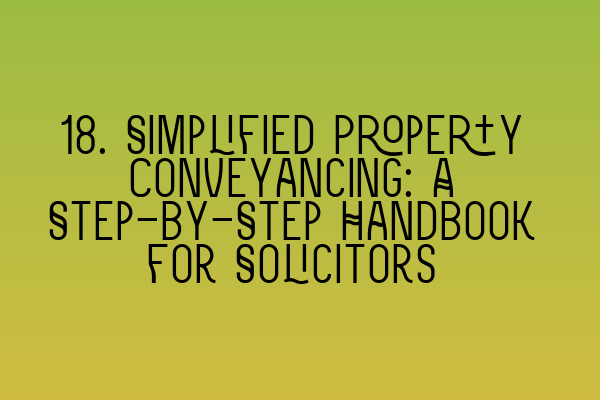Simplified Property Conveyancing: A Step-by-Step Handbook for Solicitors
At SQE Property Law & Land Law, we understand that property conveyancing can be a complex and time-consuming process. As a solicitor, it is essential to have a thorough understanding of the conveyancing process to assist your clients effectively. In this article, we have created a step-by-step handbook that provides a simplified approach to property conveyancing. Whether you are a seasoned solicitor or just starting your career, this guide will help you navigate through the conveyancing process with ease.
Step 1: Initial Instructions
The conveyancing process typically begins with receiving instructions from your client. During this stage, it is crucial to gather all the necessary details and documentation related to the property. This includes the title deeds, property information forms, and any other relevant documents.
By thoroughly reviewing the instructions and documents, you can gain a clear understanding of the property’s current situation and any potential legal issues that may arise. This step sets the foundation for the rest of the conveyancing process.
Step 2: Property Searches
Once you have reviewed the initial instructions and documents, the next step is conducting property searches. These searches are essential to identify any potential issues that may affect the property, such as planning permissions, environmental concerns, or restrictions on the property.
Common property searches include:
- Local Authority Search: This search provides information about planning permissions, building regulations, and any restrictions on the property.
- Environmental Search: This search reveals any potential risks or hazards, such as contaminated land or flooding, that may affect the property.
- Water and Drainage Search: This search confirms the property’s connection to the water and drainage system and identifies any issues that may need to be addressed.
By completing these searches, you can ensure that your clients are fully informed about the property they are purchasing or selling. It also minimizes the risk of any surprises or legal complications arising in the future.
Step 3: Drafting Contracts
Once the initial instructions are complete and the property searches have been carried out, the next step is drafting the contracts. The contract is a legally binding agreement that outlines the terms and conditions of the property transaction.
When drafting the contracts, it is essential to include all relevant information, such as the names of the parties involved, the purchase price, and any special conditions. The contracts should also address any potential issues identified during the property searches to protect your client’s interests.
It is recommended to seek professional advice and review the contracts carefully to ensure that they comply with all legal requirements and adequately protect your client’s rights.
Step 4: Exchange of Contracts
Once the contracts have been drafted and agreed upon by both parties, the next step is the exchange of contracts. This is a crucial stage in the conveyancing process as it legally binds the buyer and the seller to the transaction.
During the exchange of contracts, both parties’ solicitors will agree on a completion date and any further conditions or obligations. It is important to ensure that all necessary checks and searches have been completed, and both parties are satisfied with the terms of the contract before proceeding with the exchange.
It is also worth noting that at this stage, your client may need to pay a deposit, usually 10% of the purchase price. This deposit acts as a commitment to the transaction and is held by the seller’s solicitor until completion.
Step 5: Completion
The completion stage is the final step in the conveyancing process. On the agreed completion date, the buyer’s solicitor will transfer the remaining funds to the seller’s solicitor, and the property’s ownership will officially transfer to the buyer.
During the completion stage, it is crucial to ensure that all necessary paperwork is in order, including the transfer deed, mortgage discharge forms, and any other relevant documentation. It is also essential to carry out a final inspection of the property to ensure that it is in the agreed-upon condition.
Once the completion has taken place, it is customary to deliver the keys to the buyer, and the transaction is considered complete. It is important to complete all necessary post-completion formalities, such as registering the property transfer with the Land Registry, to ensure a smooth transition of ownership.
Conclusion
Property conveyancing can be a complex legal process, but with the right approach and knowledge, solicitors can simplify it for their clients. By following the step-by-step handbook we have provided, you can confidently guide your clients through the conveyancing process, ensuring their interests are protected and the transaction is completed smoothly.
If you would like further guidance or assistance with property conveyancing, our team at SQE Property Law & Land Law is here to help. Contact us today to discuss our services and how we can support your conveyancing needs.
Related Articles:
